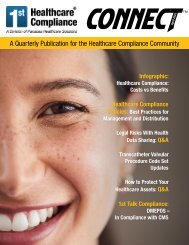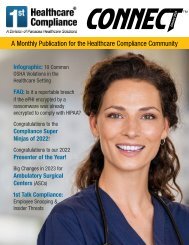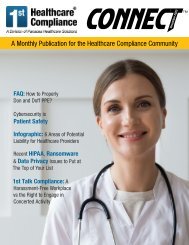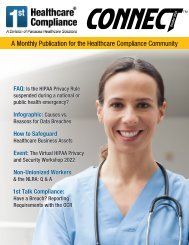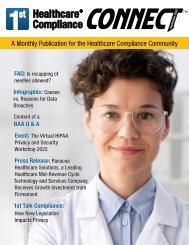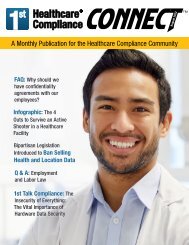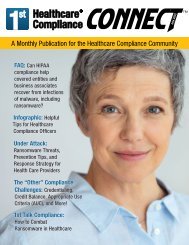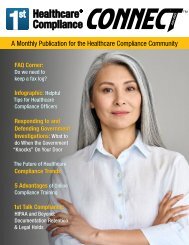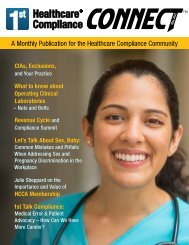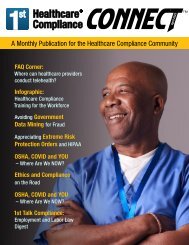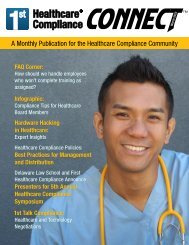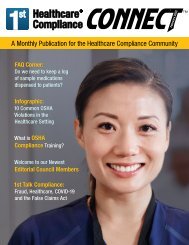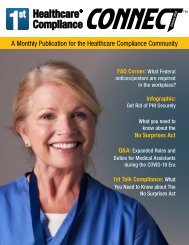First Healthcare Compliance CONNECT November 2022
You also want an ePaper? Increase the reach of your titles
YUMPU automatically turns print PDFs into web optimized ePapers that Google loves.
efficacy began to be studied. And the studies that<br />
came out even 20-30 years ago, are still relevant<br />
today because of some of the safety and patient<br />
care issues that were highlighted at that time. For<br />
example, the mislabeling of drugs, the improperly<br />
filling of dispensing cabinets, the lack of safety<br />
record procedures, numbers of doses dispensed,<br />
and the ability to override system access tracking.<br />
Today, now more than ever, and especially with the<br />
advent of the HIPAA Security Rule, which has been<br />
in effect since 2005, and then we now have the<br />
HITECH Act, in effect, the HIPAA Omnibus Rule, and<br />
then we have other laws and the related regulations<br />
as well, such as the Cybersecurity Act of 2015,<br />
all of which espouse the requirements of having<br />
adequate technical, administrative, and physical<br />
safeguards.<br />
One of the most fundamental safeguards is user<br />
ID and unique user password. There should be for<br />
every individual accessing a cabinet, there needs to<br />
be an individual user ID and password. Alternatively,<br />
some types of these devices use a biometric or<br />
fingerprint. And from there, organizations really<br />
need to look at two-factor identification. These<br />
are areas which can create significant liability, not<br />
only from a cybersecurity standpoint, but more<br />
importantly, from a patient care standpoint, which is<br />
one of the issues in the RaDonda Vaught case.<br />
Tell me about the role of the Automatic<br />
Dispensing Cabinet and the facts of the<br />
RaDonda Vaught case?<br />
What’s interesting is that there was a quote that<br />
was made by her attorney that said, while it’s not<br />
all her fault, meaning all his client’s fault, there<br />
are some real systemic problems with the way a<br />
medical center dispenses medicine through the<br />
automated dispensing systems. And so, in this<br />
case unfortunately, the nurse, the defendant, did<br />
have personal errors. It wasn’t solely the fault of<br />
the ADC. However, there were a lack of technical,<br />
administrative, and physical safeguards, there was<br />
a lack of check and balance. And that led to Ms.<br />
Murphy the patient, dying as a result of this error.<br />
So, our players in this case are Ms. Murphy, the<br />
deceased patient, RaDonda Vaught, the nurse and<br />
defendant, Vanderbilt University Medical Center<br />
(“Medical Center”), the district attorney, who<br />
The Most Comprehensive<br />
<strong>Healthcare</strong> <strong>Compliance</strong> Course<br />
The Fundamentals is a user-friendly, four-module<br />
online course designed to help healthcare professionals<br />
understand the essential principles and practices of<br />
compliance.<br />
BUY COURSE NOW<br />
Contact Toll Free: 888-54-FIRST 9




